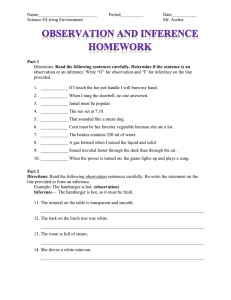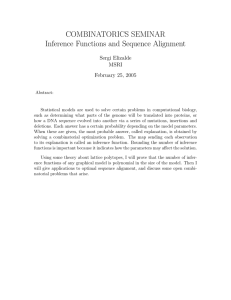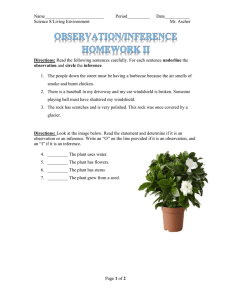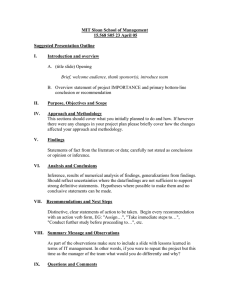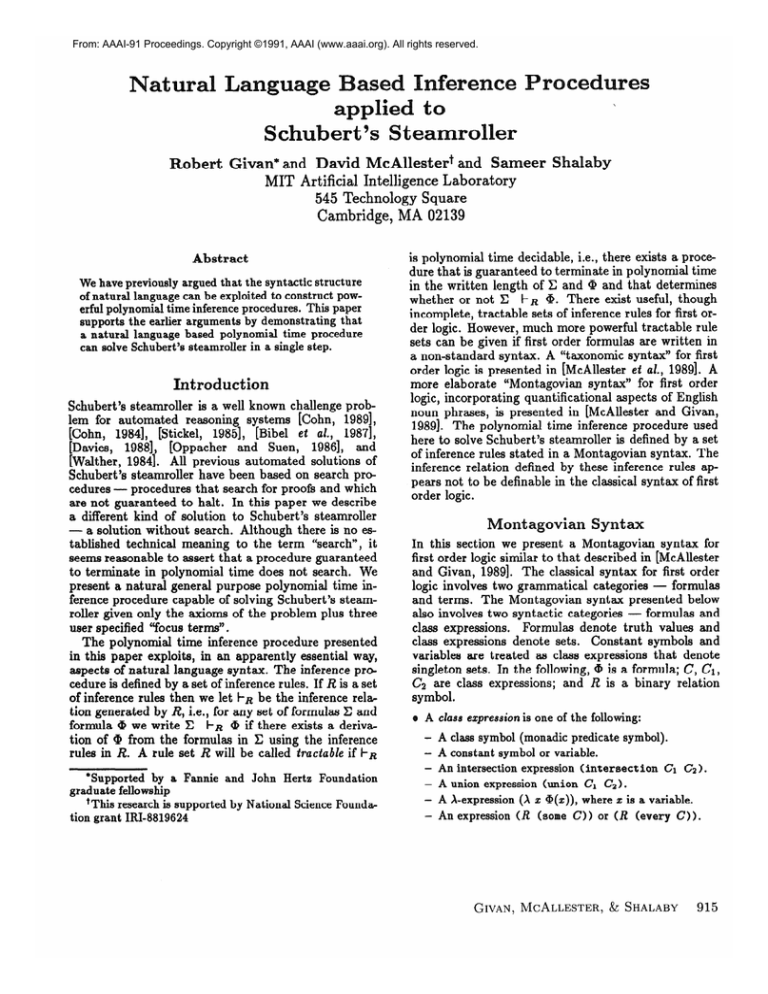
From: AAAI-91 Proceedings. Copyright ©1991, AAAI (www.aaai.org). All rights reserved.
obert Givan* and David McAllestert and Sameer Shalaby
MIT Artificial Intelligence Laboratory
545 Technology Square
Cambridge, MA 02139
Abstract
We have previously argued that the syntactic structure
of natural language can be exploited to construct powerful polynomial time inference procedures. This paper
supports the earlier arguments by demonstrating that
a natural language based polynomial time procedure
can solve Schubert’s steamroller in a single step.
Introduction
Schubert’s steamroller is a well known challenge problem for automated reasoning systems [Cohn, 19891,
[Cohn, 19841, [Stickel, 19851, [Bibel et al., 19871,
[Davies, 19881, [Oppacher and Suen, 19861, and
[Walther, 19841. All previous automated solutions of
Schubert’s steamroller have been based on search pro
cedures - procedures that search for proofs and which
are not guaranteed to halt. In this paper we describe
a different kind of solution to Schubert’s steamroller
- a solution without search. Although there is no established technical meaning to the term “search”, it
seems reasonable to assert that a procedure guaranteed
to terminate in polynomial time does not search. We
present a natural general purpose polynomial time inference procedure capable of solving Schubert’s steamroller given only the axioms of the problem plus three
user specified ‘focus terms”.
The polynomial time inference procedure presented
in this paper exploits, in an apparently essential way,
aspects of natural language syntax. The inference procedure is defined by a set of inference rules. If R is a set
of inference rules then we let l-~ be the inference relation generated by R, i.e., for any set of formulas C and
formula <p we write E f-~ @ if there exists a derivsG
tion of ip from the formulas in C using the inference
rules in R. A rule set R will be called tractable if #-R
*Supported by a Fannie and John Hertz Foundation
graduate fellowship
‘This research is supported by National Science Founds
tion grant IRI-8819624
is polynomial time decidable, i.e., there exists a procedure that is guaranteed to terminate in polynomial time
in the written length of C and @ and that determines
whether or not C b R a. There exist useful, though
incomplete, tractable sets of inference rules for first order logic. However, much more powerful tractable rule
sets can be given if first order formulas are written in
a non-standard syntax. A “taxonomic syntax” for first
order logic is presented in [McAllester et al., 19891. A
more elaborate “Montagovian syntax” for first order
logic, incorporating quantificational aspects of English
noun phrases, is presented in [McAllester and Givan,
19891. The polynomial time inference procedure used
here to solve Schubert’s steamroller is defined by a set
of inference rules stated in a Montagovian syntax. The
inference relation defined by these inference rules appears not to be definable in the classical syntax of first
order logic.
In this section we present a Montagovian syntax for
first order logic similar to that described in [McAllester
and Givan, 19891. The classical syntax for first order
logic involves two grammatical categories - formulas
and terms. The Montagovian syntax presented below
also involves two syntactic categories - formulas and
class expressions. Formulas denote truth values and
class expressions denote sets. Constant symbols and
variables are treated as class expressions that denote
singleton sets. In the following, ih is a formula; C, Cl,
Cs are class expressions; and R is a binary relation
symbol.
e A class eqwession is one of the following:
- A class symbol (monadic predicate symbol).
- A constant symbol or variable.
- An intersection expression (intersection
Cl Cz ).
- A union expression (union Cl C,>.
-
A X-expression (X x Q(x)), where z is a variable.
-
An expression (R
(some C))
GIVAN, MCALLESTER,
or (R
(every
& SHALABY
C)).
915
I
o A formula is one of the following:
- A subset formula of the form (every Cl 62).
- An intersection formula of the form (some Cl C2 1.
- An existence formula of the form (there-exists-a
0.
- An at-most-one formula of the form (at-most-one C).
- Any Boolean combination of the above formulas.
Before giving a formal semantics, it is useful to consider some examples of formulas and their associated
meanings. If P and Q are class symbols then (every
P q) is a formula which is. true if the set denoted by
P is a subset of the set denoted by Q. If man is a class
symbol that denotes the set of all men, and runs is
a class symbol that denotes the set of all things that
run, then the formula (every man runs) is true if every man runs. The formula (some man runs) is true if
some man runs.
If John is a constant symbol (or variable) then the formulas (every John runs) and (some John runs) are
semantically equivalent and we can use (John runs) as
an abbreviation for either formula. Similarly, we write
(likes
John) as an abbreviation for either of the class
expressions (likes
(every John) ) or (likes
(some
John) ) .
If owns is a relation symbol, and denotes the predicate which is true of two objects if the first owns the
second, then the class expression (owns (some car) )
denotes the set of individuals that own some car. If
policeman is a class symbol that denotes the set of all
policemen, then the formula (every policeman (owns
(some car) ) ) is true if every policeman owns a car.
Our formal semantics for the Mont.agovian syntax is
a (drastic) simplification of Monta ue’s original semantics for English [Montague, 19741.F Just as in classical
syntax, a model of our Montagovian language is a first
order model, i.e., a domain D together with an interpretation of constant, class, and relation symbols. Each
first order model interprets each constant symbol as an
element of its domain. A model also interprets each
class symbol as a subset of its domain and each relation symbol as a binary relation on its domain, i.e., a
set of pairs of domain elements.
If M is a first order model, and p is a variable interpretation over M, i.e., a mapping from variables to
elements of the domain of M, then we write V(e, M, p)
for the semantic value of the expression e in the model
M under variable interpretation p. If C is a class expression then Y(C, M, p) is a subset of the domain of
‘Our class expressions play the role of both verb phrases,
as in (owns (some car) ) , and of incomplete noun phrases,
as in (brother-of
(some policeman)).
Montague, of
course, treated these as separate syntactic categories. Montague also treated complete noun phrases, such as (every
policeman), as another syntactic category with its own denotational semantics. The treatment of propositional attitudes makes Montague’s formal language yet more complex.
916
TRACTABLE
INFERENCE
M. If @ is a formula, then V(@, M ,p) is a truth value,
either T or F.
a For class symbol P, V(P, M,
p) is the set M(P).
a For constant c, V(c, M, p) is the singleton set (M(c)).
a For variable x, V(x, M, p) is the singleton set {p(x)}.
a Y (intersection
Y IC2, M
CI CZ),
M,
p) is V(G,
M,
p) n
M,
p) U
P).
a V( (union Cl C2),
V(C2, M, p).
M,
p) is the set V(C1,
0 v (A x Q(x)),
M, p) is the set of all d such that
V l @(x), M P[X := d]) is T where p[x := d] is the same
as p except that it interprets x as d.
0 V( (R (every C) ), M, p) is the set of all cl such that for
every d’ in V(C, M, p) the pair cd, d’> is an element of
the relation denoted by R. (Consider the class expression
(loves (every child) I.)
a V( (R (some C)), M, p) is the set of all d such that there
exists an element d’in V(C, M, p) such that that the pair
<d, d’> is an element of the relation denoted by R. (Con-
sider the class expression (loves
0 V((ewery
C W),
(some child)).)
M, p) is T if the set V(C, M, p) is a
subset of V(W, M, p).
0 V( (some C W,
M,
p) is ‘I! if the setV(C,
V(W, M, p) is non-empty.
a V( (there-exists-a
non-empty.
a V((at-most-one C),
most one member.
C),
M,
M,
p) n
p) is T if V(C, M p) is
M, p) is T if V(C, M p) has at
a Boolean combinations of atomic formulas have their standard meaning.
Binary relation symbols, in the presence of equality,
are in some sense sufficient to express arbitrary first order facts. We leave it to the reader to verify that, if
we restrict our attention to languages with only constants and unary and binary relation symbols, then every classical first order formula can be translated to a
logically equivalent formula of Mont agovian syntax and
vice versa. Montagovian syntax is really just a syntactic
variant of first order logic.
Schubert’s Steamroller
Schubert’s steamroller is a logical puzzle originally
stated in English. Each sentence of the English statement of the problem is given below along with a translation of that sentence into a set of formulas in our
Montagovian syntax for first order logic.
Wolves, foxes, birds, caterpillars, and snails are animals, and there are some of each of them.
(every
wolf animal)
(every fox animal)
. . . etc.
(there-exists-a
(there-exists-a
wolf)
fox)
There are some grains, and grains are plants.
(there-exists-a
grain)
(every
grain
plant)
Caterpillars
and snails are much smaller than birds,
which are much smaller than foxes, which are much
smaller than wolves.
(everycaterpillar
(is-smaller-than
(everybird)))
(everysnail (is-smaller-than(everybird)))
(everybird (is-smaller-than(everyfox)))
(everyfox (is-smaller-than
(everywolf)))
Wolves doI not like to eat foxes or grains, while birds
but not snails.
lie to eat caterpillars
i(aome wolf (eats (some fox)))
l(aome wolf (eats (some grain)))
(everybird (eats (every caterpillar)))
-(aone bird (eats (some snail)))
Caterpillars and snails like to eat some plants.
(every
(every
caterpillar(eats (some plant)))
snail (eats (some plant)))
Every animal either likes to eat all plants or all animals
much smaller than itself that like to eat some plants.
(everyanimal
(union
(eats (everyplant))
(A z (z (eats (every
(intersection
animal
(is-smaller-than
%))))I
1))
Prove there is an animal that likes to eat a grain-eating
animal.
(some animal.
(eats
(some (intersection
animal
(eats (some grain))))))
A formulaof Montagovian Syntax is called quantifierfnee if it does not contain any X-expressions. The “quantifiers” some and every that appear in noun phrases
are considered to be quantifier-free combinators.
In
[McAllester and Givan, 19891 we show that satisfiability is decidable (NP-complete) for the quantifier-free
fragment of the Montagovian syntax presented in that
paper. Although the Montagovian syntax presented
here is somewhat more elaborate, we conjecture that
the quantifier-free fragment remains decidable. When
translated into our Montagovian syntax, all of the sentences of Schubert’s steamroller are quantifier-free except for the second to last sentence above, which involves a single &expression.
Polynomial Time Inference
Figure 1 gives a set of 33 inference rules stated in our
Montagovian syntax. We are actually interested in the
rules in figure 1 plus all contrapositives of those rules.
Each inference rule is analogous to an implication of the
is an antecedent
form !&I A . . . Q, + @ where each Q\E~
and @ is the conclusion. A contrapositive of a rule Qi A
. . . gsr, + QBis a rule of the form
91 A*** A !I!;,1
A lQ[, A 9i+l
A . a. A 9,
-+ +&.
In the contrapositive, the conclusion has been interchanged with one of the antecedents and both of the
interchanged formulas have been negated. If a given
rule is semantically sound, then so is each of its contrapositives. We conjecture that the rule set consisting
of the rules in figure 1 plus all contrapositives of those
rules is local (see below), and thus generates a polynomial time decidable inference relation.
The inference rules in figure 1, together with their
contrapositives, determine a sound inference relation
for formulas expressed in our Montagovian syntax for
first order logic. This (incomplete) first order inference relation appears not have any definition in the
classical syntax for first order logic. 2 We have constructed a polynomial time inference procedure based
on this set of inference rules. A general theoretical
framework for constructin polynomial time inference
procedures is presented in BMcAllester, 19901. Let R be
any set of inference rules. The following definition is
from [McAllester, 19901.
Definition:
We write C l+~ @ if there exists a
proof of Qpfrom the premise set C such that every
proper subezpwssion of a formula used in the proof
appears as a proper subexpression of iB, a proper
subexpression of some formula in C, or as a closed
(variable free) expression in the rule set R.
The following lemma is proved in [McAllester, 19901 .
For any given rule set R, there exists a
procedure for determining whether or not C l-~R Q
which runs in time polynomial in the written length
of C and a.
Lemma:
The inference relation I-1R is a restricted version of
l-~. For any rule set R, the relation l+ R is polynomial
time decidable. If the relation I-R is intractable, as is the
case for any sound and complete set of rules for first order logic, then the polynomial time relation I+R will be
weaker than the relation ER. Rowever, there is a large
class of rule sets for which these two relations are the
same. The following definition is also from [McAllester,
19901 .
A set R of inference rules is called
local if the relation I+R is the same as the relation
Definition:
J-R*
2This is because the variables in the rules of figure 1
range over class expressions, but there are no class expressions in classical syntax. Consider for example the classical
equivalent of the Montagovian class expression (brother-of
(everyman)).
GIVAN, MCALLESTER,
& SHALABY
917
(7)
(10)
(every
C C)
(8)
(there-exists-a
(there-exists-a
(11)
C)
(16)
(there-exists-a
(every
(every
C W)
W 2)
(every
C 2)
(14)
W)
(at-most-one
C)
C W)
C W))
(every
C (union
(21)
(every
(intersection
(23)
(every
C Z),
C W) Cl
(every
(every (union C W)
(27)
(29)
(31)
W 2)
(there-exists-a
(intersection
(every
C (union
W 2))
(every
C Z)
(every
C W)
(every
(R
C W)
(R
(R (every
C)
C WI
C W)
-(every
(there-exists-a
(every
W (union C W) )
(22)
(every
(intersection
(24)
(every
2 C),
(every
2
(26)
-(there-exists-a
C)
C W) W)
(every
2 W)
(intersection
C W))
C)
(every W (R (every C)) 1
(28)
(some W) ))
(some W) ) )
(some C W)
(at-most-one
(20)
(every
C (union
(every
C W)
-r(some C 2)
W 2))
(every C W)
(every CR (every W))
(32)
C) ) (R
08)
C)
C W))
(some C W)
(every
C)
(30)
(some C))
c)
(some C W)
(every
2)
(some C W)
-(some
(15)
(there-exists-a
(19)
(25)
-(at-most-one
(17)
(at-most-one
(some W Cl
C)
(some c W)
(every C 2)
(some 2 W)
(at-most-one
(every
(12)
(some C W)
(some C C)
(13)
(9)
c)
(R (every
(there-exists-a
(R (some C) ))
(there-exists-a
C)
C) ))
Figure 1: Some inference rules for Montagovian Syntax. The letters 6, IV, and 2, range over class expressions, c
ranges over constants and variables, Q and \Erange over formulas, and R ranges over relation symbols.
An immediate consequence of the above definitions
and lemma is that local rule sets are tractable, i.e., they
generate polynomial time decidable inference relations.
A variety of nontrivial local rule sets is presented in
[McAllester, 19901. Let M be the set of inference rules
in figure 1 together with the contrapositives of those
rules. We conjecture, although we have not yet proved,
that M is local. Even if M is not local, b M is still
polynomial time decidable, and it appears to be a very
powerful inference relation.
ence rules given in the previous section are not complete
for our Montagovian syntax for first order logic. Wowever, it is possible to exploit fast and powerful inference
procedures based on Montagovian syntax in constructing semi-automated verification systems. In this section
we describe a particular kind of semi-automated verification system called a Socratic Sequent system.3 A
proof in a Socratic sequent system is a series of lines
where each line is a sequent of the form C I- Qpwhere
C is a set of formulas and Q is a formula.
Socratic Proof Systems
3The term “Socr atic proof” was introduced in [Crawford
and Kuipers, 19891 to describe any system in which steps of
a proof are verified using an automated reasoning procedure.
Our notion of a Socratic sequent system is a special case of
this general concept.
Local rule sets define polynomial time inference procedures. Of course, no polynomial time inference procedure can be complete for first order logic - the 32 infer-
918
TRACTABLE
INFERENCE
A Socratic sequent system is a pair
<R, S> where R is a set of inference rules (deriving formulas from formulas) and S is a set of
sequent rules (deriving sequents from sequents).
Definition:
An acceptable derivation in a Socratic sequent system <R, S> is a series of sequents
where, for each sequent C I- a, either C I- R ip
(in which case the sequent is called obvious), or the
sequent follows from earlier sequents using a rule
in S.
Definition:
If the rule set R that defines the obvious sequent8 is
local, then the inference relation t-R is polynomial time
decidable, and one can therefore determine, in polynomial time, whether a series of sequents is an acceptable
derivation in the sequent system <R, S>. (Note that
finding an acceptable derivation of @ from C is still an
undecidable operation-the
critical point is that once
we have such a derivation, we can ver;fu that it is acceptable in polynomial time).
In this section we give a Socratic sequent system that
is complete for our Montagovian syntax for first order
logic and show how this Socratic system yields a onestep solution to Schubert’s steamroller. The sequent
rules for our proof system are given in figure 2. The
rules of obviousness of our Socratic system include all
of the inference rules in figure 1 plus the following two
rules concerning &expressions:
(33)
a(y),(focus-on81)
(everyg (Xx@(x)))
(34)
(every
0 (Xx a(z))>,
(focus-on
g)
WY)
Each of these rules has an antecedent of the form
(focus-any),
where g must be variable. Formulas of
this form are used to control the inference process and
have no semantic content. The f ecus-on antecedents
of the above rules restrict the application of these rules
to “focus variables”, i.e., variables v such that the formula (focus-any)
is given as a premise (there are
no inference rules for deriving formulas of the form
(focus-any)).
Note that the sequent rule S3 in figure 2 can be used to eliminate focus-on premises from
sequents. If the A-expression rules were not restricted
with focus-on antecedents, then the inference relation
defined by those rules, together with the rules of figure 1, would be undecidable.
Let M’ be the set of
inference rules including all rules in figure 1 and their
contrapositives, plus the above two rules for quantifiers.
We have a polynomial time implementation of the inference relation H MI, provided there is a bounded level
of A-nesting. This im lementation is constructed along
the lines described in PMcAllester, 19891. We conjecture
that M’ is local, and thus that I-(M/ is the same as i-M,.
Now let C be the set of formulas of Montagovian syntax used to represent the premises of Schubert’s steamroller as given in section and let @ be the formula to be
proven. Our implementation of an inference procedure
for the rule set M’ has been used to verify that:
CU
(xw wolf)9 (fecus-on x,) ,
(xf fox), (focus-onzf),
(za bird) , (focus-on
t-M’ Q[,
zb)
This sequent expresses the English statement “to see
that Qhfollows from C, consider a wolf Q, , a fox zp ,
and a bird zb - the result is then obvious”. Repeated
use of the Socratic inference rules S3 and S5 can be
used to eliminate all premises other than C, and hence
derive the sequent C l- a. A simple user interface to
the Socratic proof system can be used to automatically
apply sequent rules, such as S3 and S5, that remove extraneous premises. Given this user interface, the above
sequent is a one line solution to Schubert’s steamroller.
iscussion
We have constructed a complete proof system for a nonstandard syntax for first order logic. This proof system
has the simultaneous features that proofs are short and
yet, if our conjectures are correct, the acceptability of a
proof is quickly verifiable. The proofs in our system are
so short that Schubert’s steamroller can be proved in a
single line, by far the shortest known proof in a proof
system with polynomial time checkable proofs.
The conciseness of the proofs in our proof system
appears to be due to the power (and conjectured locality) of the inference rules given in figure 1. This
power appears to depend fundamentally on the use of
a non-standard syntax to express the inference rulesjust what aspect of the new syntax makes this added
expression possible is unclear, but one relevant observation is that the quantifier free fragment of the new
syntax can express many facts which require quantifiers in classical syntax (e.g. (every man mammal)).
Our experience indicates that the decision procedure
for the inference relation b M immediately solves the
vast majority of inference problems that can be stated
in the fragment of Montagovian syntax that does not
contain X-quantifiers.4 The statement of Schubert’s
steamroller in Montagovian syntax contains only a single X-quantifier a quantifier needed to represent
the English anaphora “itself’. Three instantiations of
this quantifier are needed in the solution of Schubert’s
steamroller. Our one-line solution specifies the objects
on which the quantifier is to be instantiated - the
focus-on premises in the one-line solution control the
use of the instantiation rules 34 and 35.
The inference relation defined by the inference rules
in figure 1 appears not to have any definition in the
classical syntax of first order logic. Thus, Montagovian syntax appears to play an essential role in the
‘We conjecture that validity in the X-free fragment of our
Montagovian syntax is decidable, although it is known that
the inference rules in figure 1 are not complete for A-free
Montagovian formulas.
GIVAN, MCALLESTER,
& SHALABY
919
w
w
C U (fecus-on 2) f- @
w
Cu(*}k4!
cl-0
(there-exists-a
(S5)CCUI-((every
x Cl} I-
6)
(S6)
Q
C I- home
C U i (every
C W)
2 Cl,
(every x W)} t- Q
2 C>}
t- (every x W)
cl-a
cw
C U ((every
2 C>} t- (every W (R x) )
w
C t- (every- C W)
C I- (every W (R (every 0))
w
C I- (at-most-one
2)
C I- (every Z (R (some C) 1)
C U {(every
2 C),
C U ((every
(SlO)
(every Z (R x:)1} I- @
C U {(every
21 Cl, (every 22 C>} I- (every x1 x2)
C t- ((at-most-one
0)
Figure 2: The Socratic Proof Rules. In these rules 6, W, and Z, are class expressions, @ is a formula, and x, xl and
22 are variables that do not appear free in I=, Qp,C, 2, or W.
specification of the inference relation and therefore in
the construction of the a Socratic sequent system with
extremely concise proofs. Although this suggests that
natural language syntax plays an important role in human reasoning, it seems sufficient to merely claim that
aspects of natural language syntax can be used to build
powerful inference algorithms .
References
W. Bibel, R. Letz, and J. Schumann. Bottom-up enhancements of deductive systems. In Proceedings of
the Fourth International Conference on Artificial Intelligence and Information Control Systems of Robots,
pages 1-9. North-Holland, Amsterdam, Netherlands,
October 1987.
A. G. Cohn. A note concerning the axiomatization of
Schubert’s steamroller in many sorted logic. In Alvey
IKBS Inference Research Theme Workshop, pages 1421. Alvey Directorate, London, England, September
1984.
A. G. Cohn. Taxonomic reasoning with many-sorted
logics. Artificial Intelligence Review, 3(2-3):89-128,
1989.
J. M. Crawford and Benjamin Kuipers. Towards a
theory of access-limited logic for knowledge representation. In First International Conference on Principles
of Knowledge Representation and Reasoning, pages
6?-78,1989.
N. Davies. Schubert’s steamroller in a natural deduction theorem prover. In Proceedings of Computer Society Specialist Group on Expert Systems, pages 89-102.
Cambridge University Press, Cambridge, UK, December 1988.
920
TRACTABLE
INFERENCE
D. McAllester and R. Givan. Natural language syntax
and first order inference. Memo 1176, MIT Artificial
Intelligence Laboratory, October 1989. To Appear in
AIJ.
D. McAllester, R. Givan, and T. Fatima. Taxonomic
syntax for first order inference. In Proceedings of
the First International Conference on Principles of
Knowledge Representation and Reasoning, pages 289300, 1989. To Appear in JACM.
David A. McAllester. Ontic: A Knowledge Representation System for Mathematics. MIT Press, 1989.
D. McAllester. Automatic recognition of tractability
in inference relations. Memo 1215, MIT Artificial Intelligence Laboratory, February 1990. To appear in
JACM.
Richard Montague. English as a formal language. In
R. H. Thomason, editor, Formal Philosophy: Selected
Papers of RichaTd Montague. Yale University Press,
1974.
F. Oppacher and E. Suen. Controlling deduction with
proof condensation and heuristics. In International
Conference on Automated Deduction, pages 384-93.
Springer-Verlag, Berlin, Germany, July 1986.
Mark E. Stickel. Automated deduction by theory resolution. Journal of Automated Reasoning, 1:333-355,
1985.
Christoph Walther. A mechanical solution of schubert’s steamroller by many-sorted resolution. In Proceedings of AAAI-84, pages 330-334, 1984.


